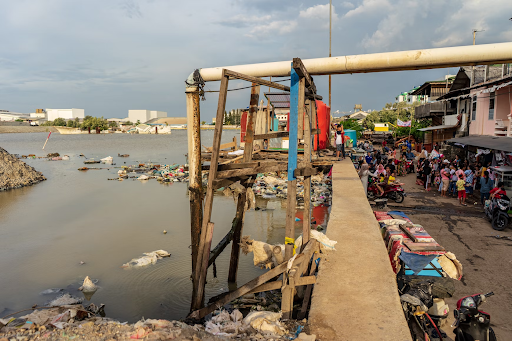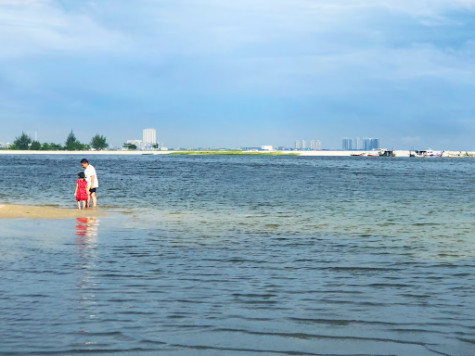In the Era of Climate Change, Jakarta Fights to Stay Afloat
At a rate of 25 centimeters a year, Jakarta is the fastest sinking city in the world. Without proper action, it could be the first megacity lost to climate change.

A crumbling wall is the only current remedy for residents living in Muara Baru, an area of Jakarta that has sunk fourteen feet in recent years. Behind the wall, citizens congregate as usual.
Nature doesn’t wait.
Across the city of Jakarta, rising sea levels and extreme weather have flooded bazaars, contaminated freshwater aquifers, and eroded coastlines. Several miles away, industrial factories and suburban residences have become nothing more than dilapidated shacks covered in scattered ocean debris and mildew. With a population of over 11 million, the capital of Indonesia is being swallowed by the Java Sea — at a rate much faster than scientists originally expected.
The problem? Subsidence.
Largely due to underground material movement, subsidence is a process by which land gradually sinks into the Earth’s surface. When resources like water, oil, or minerals are removed from the Earth, or when natural disasters alter land formation, the ground surface begins to collapse. In the age of climate change and rising sea levels, subsidence accelerates flooding, and subsequently, a region’s vulnerability.
Jakartans have been extracting groundwater to survive — a practice that precedes modern Indonesia and takes root in the age of European colonialism. In the 17th century, Dutch settlers built canal systems to stimulate trade and imitate a Western hierarchy, in effect segregating the city and excluding Indigenous Jakartans through an unequal water system. Now, less than half of the city’s residents have access to piped water.
The main concern today, however, is not the fragmented water network but instead poor urban development. Scholars have concluded that Jakarta’s subsidence is due to the creation of illegal wells that tarnished underground aquifers. Neglecting the wealth inequality, rapid urbanization, and corruption that run rampant in the city, this proposed explanation only offers a half-truth.
Although digging illegal wells seems like a citywide exercise, it is limited to the wealthy. Powerful and innovative pumps are needed to extract and purify groundwater, in turn depleting impoverished areas of water access and treatment technology. Because the city’s poorest residents typically live in low-lying coastal areas, they are also the first to experience higher flooding and water contamination.
Groundwater extraction occurs on a massive scale, which destroys any hope of self-sufficiency. “[B]ecause of the rapid urbanization over the last 30 years, the amount of permeable surface has decreased to a point where you don’t have enough recharge in the groundwater,” said Dr. Kian Goh, Assistant Professor of Urban Planning at the University of California, Los Angeles, who has researched Jakarta in depth. Because more than 97 percent of Jakarta is covered in concrete and asphalt, the number of fields and mangroves that can absorb excess water has decreased drastically.
When natural solutions fail, man-made remedies typically step in. In Jakarta, however, progress has stalled due to government corruption and public distrust. The state’s unfulfilled promise of religious freedom has fueled conflict between Islamic extremists and secular Indonesians, thereby ousting progressive leaders from power. Residents in vulnerable areas have now learned to adapt to floods and other water crises, which makes any governmental reform too little, too late.

It was not until multiple climate disasters struck that the government was forced to reconsider urban planning. Over the past decade, severe floods have killed hundreds and forced hundreds of thousands to evacuate. “We had to make tents and sleep on the roof,” said Lupus, an Indonesian resident who survived four-meter-deep floods in 2007.
Thus, one exception has been made in recent years: sea walls. The Indonesian government has constructed more than twenty kilometers of sea walls along coastlines and river banks in hopes of buying the city some time. The most ambitious plan is the Great Garuda, a massive sea wall in the shape of a mythical eagle with outstretched wings — Indonesia’s national symbol. Optimistically, the Great Garuda would protect Jakarta from flooding and serve as a new economic hub on the waterfront with 300,000 inhabitants.
In reality, if the government does nothing to address land subsidence and the rapid draining of groundwater, the city’s sinking will bring down the sea walls with it. Even in the best-case scenario, the Great Garuda is estimated to take around 35 years to complete, implying that any benefits would only come about after decades of construction emissions and more inevitable floods.
“If the chance of extreme weather is high, then an honest conversation should be had about whether we can afford to keep rebuilding back in the same way,” said Mr. Matthew Sarker, A.P. Physics 1 and Green Design teacher at Bronx Science. “It’s not smart to be in a situation where you’re paying millions of dollars to keep rebuilding in flood prone areas. A proactive approach might make sense and be a win-win for everyone.”
Indonesian officials agree. After years of making ineffective amends to the status quo, Jakarta is left with one option: relocation.
This past January 2022, the Indonesian House of Representatives approved a bill to move the capital city of Jakarta to the island of Borneo, or Kalimantan in Javanese, which is much less susceptible to climate disasters. Projected to cost over $32 billion, the extravagant move will not only bring all of Jakarta’s government agencies, economic industries, and cultural institutions to Borneo, but will also give Indonesia’s capital a chance to start anew. The new city, around 1,200 miles northeast of Jakarta, will be named Nusantara, meaning ‘archipelago’ in Old Javanese.
In an effort to promote sustainability, Indonesian officials, such as President Joko “Jokowi” Widodo, are focused on using innovation and technology to build a ‘smart city.’ The project’s technicalities will be headed by Sheikh Mohamed bin Zayed al Nahyan, the Crown Prince of the United Arab Emirates, who has completed similar cutting-edge projects in Abu Dhabi.
Ecologically, the idea of “building a city” isn’t so simple. Specifically, in the case of Borneo, the island is home to hundreds upon thousands of unique animal and plant species. As one of the most biodiverse regions on Earth, Borneo faces severe threats to its wildlife preservation and water systems if the island and its people are forced to adapt to the integration of a megacity. If officials do not address the root cause of rapid, unsustainable urbanization, Borneo will eventually become every bit as polluted as Jakarta is today, laden with smog, contamination, and no parks in sight.
Economists, on the other hand, are concerned about Nusantara’s costs. Building is currently estimated to be at 466 trillion Rp (Indonesian Rupiahs), or around USD 32.7 billion — a concerning number amid pandemic recovery. Around 19% will come from the state, and the rest will be funded by a combined effort between the private sector and other countries, such as Saudi Arabia, China, and Russia.

“Climate change is not an issue where a specific country is at fault,” said Manu Bosteels ’24, who helps organize climate initiatives at Bronx Science. “Foreign intervention is necessary to make the switch as smooth as possible, and those in power need to work together to decrease the effects of climate disasters and keep the general public from getting hurt.”
The first phase of the relocation project is expected to be finished by 2024, which will necessitate clearing 138,800 acres of land to build a presidential palace, government buildings, schools, and central road infrastructure. Although the unused island is suitable for rebuilding, critics worry that demolishing miles of forests and wildlife will contribute to the destruction of the natural biodiversity and exacerbate the harms of urbanization.
Nonetheless, a transition is necessary.
Already 40% of Jakarta is under sea level, and over 95% of northern areas will be underwater by 2050. Labeled by climate scientists as the fastest sinking city in the world, Jakarta does not have time to spare.
While grandiose plans like the Great Garuda and relocation are underway, they are not an immediate, complete solution to the imminent problem. Many Jakartan residents will opt to stay in their hometown, and officials will need to act responsibly and restore hope in a city on the brink of collapse.
Thus, recovery is starting small. For one, planners aim to renovate Jakarta’s reservoirs and flood canals. One strategy is to follow in the footsteps of other cities in Southeast Asia. Singapore, for example, has diversified its water supply with local, imported, reclaimed, and desalinated water. Outside of water systems, Jakarta’s government has also set the goal of increasing open, green spaces from 10% to 30% by 2030, which ideally will not only absorb floods but also decrease air pollution on a broader scale.
“The most important step in combating climate change is understanding that we are past the point where we can reverse all its effects,” Bosteels continued. “To maintain that perspective is to ignore the countless disasters that are ongoing internationally; at this point, climate action is working to prevent the worst effects of climate change.”
“If the chance of extreme weather is high, then an honest conversation should be had about whether we can afford to keep rebuilding back in the same way,” said Mr. Matthew Sarker, A.P. Physics 1 and Green Design teacher at Bronx Science. “It’s not smart to be in a situation where you’re paying millions of dollars to keep rebuilding in flood prone areas. A proactive approach might make sense and be a win-win for everyone.”
Charlotte Zhou is an Editor-in-Chief for ‘The Science Survey.’ In addition to writing and editing articles, she constructs the online crossword and...










